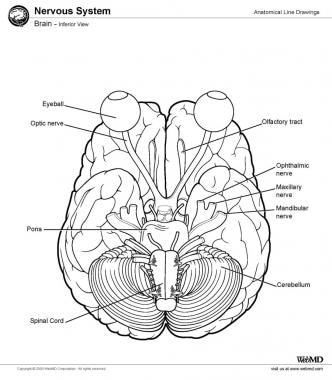
The neocortex is the most phylogenetically developed structure
of the human brain as compared with the brains of other species. The
complex pattern of folding allows an increased cortical surface to
occupy a smaller cranial volume. The pattern of folding that forms the
sulcal and gyral patterns remains highly preserved across individuals.
This enables a nomenclature for the cortical anatomy.
The left and right cerebral hemispheres are separated by the
longitudinal cerebral fissure. The principal connection between the 2
hemispheres is the corpus callosum. Each cortical hemisphere can be
divided into 4 lobes: frontal, temporal, parietal, and occipital. The
frontal lobe can be distinguished from the temporal lobe by the lateral
sulcus (Sylvian fissure). The frontal lobe can be distinguished from the
parietal lobe by the central sulcus (Rolandic fissure). The
parieto-occipital sulcus, which is visible on the medial aspect of the
hemisphere, divides the parietal and occipital lobes. Within the lateral
sulcus is another cortical surface referred to as the insula.
The frontal lobe can then be further divided into the
superior, middle, and inferior frontal gyri, which are divided by the
superior and inferior frontal sulci, respectively. The inferior frontal
gyrus forms the frontal operculum, which overlies the lateral sulcus.
The frontal operculum can be divided into 3 triangular gyri: the pars
orbitalis, the pars triangularis, and the pars opercularis, in order
from anterior to posterior. The precentral gyrus is the gyrus
immediately anterior to the central sulcus.
Similarly, the temporal lobe is divided into the superior,
middle, and inferior temporal gyri, which are separated by the superior
and inferior temporal sulci. On the inferior surface of the temporal
lobe just lateral to the midbrain the parahippocampal gyrus can be
identified, with the collateral sulcus lying lateral. Between the
parahippocampal gyrus and the inferior temporal gyrus lies the
occipitotemporal gyrus, also known as the fusiform gyrus.
Within the parietal lobe, the superior temporal sulcus is
capped by the angular gyrus. Just above this, the lateral sulcus is
capped by the supramarginal gyrus. Just below the angular gyrus, the
lateral occipital gyrus caps the inferior temporal sulcus.



0 Comments:
Post a Comment